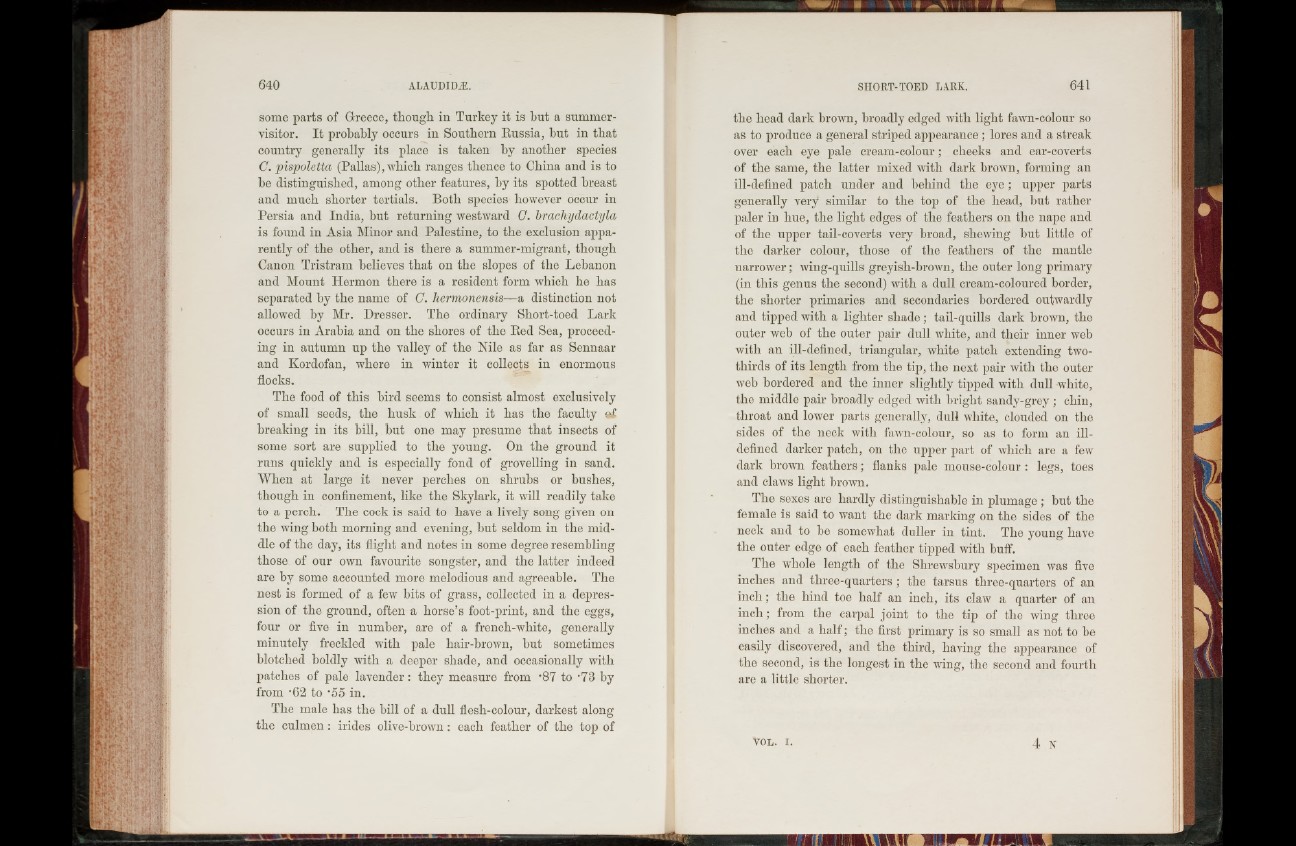
some parts of Greece, though in Turkey it is hut a summer-
visitor. I t probably occurs in Southern Eussia, but in that
country generally its place is taken by another species
C. pispoletta (Pallas), which ranges thence to China and is to
be distinguished, among other features, by its spotted breast
and much shorter tertials. Both species however occur in
Persia and India, but returning westward G. brachydactyla
is found in Asia Minor and Palestine, to the exclusion apparently
of the other, and is there a summer-migrant, though
Canon Tristram believes that on the slopes of the Lebanon
and Mount Hermon there is a resident form which he has
separated by the name of C. hermonensis—a distinction not
allowed by Mr. Dresser. The ordinary Short-toed Lark
occurs in Arabia and on the shores of the Eed Sea, proceeding
in autumn up the valley of the Nile as far as Sennaar
and Kordofan, where in winter it collects in enormous
flocks.
The food of this bird seems to consist almost exclusively
of small seeds, the husk of which it has the faculty e£
breaking in its bill, but one may presume that insects of
some sort are supplied to the young. On the ground it
runs quickly and is especially fond of grovelling in sand.
When at large it never perches on shrubs or hushes,
though in confinement, like the Skylark, it will readily take
to a perch. The cock is said to have a lively song given on
the wing both morning and evening, but seldom in the middle
of the day, its flight and notes in some degree resembling
those of our own favourite songster, and the latter indeed
are by some accounted more melodious and agreeable. The
nest is formed of a few bits of grass, collected in a depression
of the ground, often a horse’s foot-print, and the eggs,
four or five in number, are of a french-white, generally
minutely freckled with pale hair-brown, but sometimes
blotched boldly with a deeper shade, and occasionally with
patches of pale lavender: they measure from *87 to -73 by
from ‘62 to '55 in.
The male has the bill of a dull flesh-colour, darkest along
the culrnen: irides olive-brown: each feather of the top of
the head dark brown, broadly edged with light fawn-colour so
as to produce a general striped appearance ; lores and a streak
over each eye pale cream-colour; cheeks and ear-coverts
of the same, the latter mixed with dark brown, forming an
ill-defined patch under and behind the eye ; upper parts
generally very similar to the top of the head, but rather
paler in hue, the light edges of the feathers on the nape and
of the upper tail-coverts very broad, shewing but little of
the darker colour, those of the feathers of the mantle
narrower; wing-quills greyisli-brown, the outer long primary
(in this genus the second) with a dull cream-coloured border,
the shorter primaries and secondaries bordered outwardly
and tipped with a lighter shade; tail-quills dark brown, the
outer web of the outer pair dull white, and their inner web
with an ill-defined, triangular, white patch extending two-
thirds of its length from the tip, the next pair with the outer
web bordered and the inner slightly tipped with dull white,
the middle pair broadly edged with bright sandy-grey ; chin,
throat and lower parts generally, dull white, clouded on the
sides of the neck with fawn-colour, so as to form an ill-
defined darker patch, on the upper part of which are a few
dark brown feathers; flanks pale mouse-colour : legs, toes
and claws light brown.
The sexes are hardly distinguishable in plumage ; but the
female is said to want the dark marking on the sides of the
neck and to be somewhat duller in tint. The young have
the outer edge of each feather tipped with buff.
The whole length of the Shrewsbury specimen was five
inches and three-quarters ; the tarsus three-quarters of an
in ch ; the hind toe half an inch, its claw a quarter of an
in c h ; from the carpal joint to the tip of the wing three
inches and a half; the first primary is so small as not to be
easily discovered, and the third, having the appearance of
the second, is the longest in the wing, the second and fourth
are a little shorter.
VOL. I .